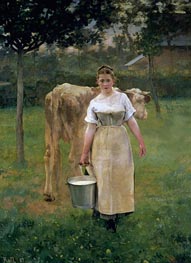
Alfred Philippe Roll Giclée Fine Art Prints
1846-1919
French Realist Painter
Alfred Philippe Roll stands as one of those painters who navigated the complexities of a shifting era in French art, moving from romanticism to realism with a dexterity that reveals his acute sensitivity to the world around him. Born in 1846, Roll trained at the École des Beaux-Arts under renowned masters like Jean-Léon Gérôme and Léon Bonnat. His early work, shaped by the formal traditions of Bolognese painting and Gustave Courbet’s realism, still retained a romantic echo, as seen in pieces like "Environs of Baccarat." But Roll was a painter destined for transformation - one that would reflect not only his artistic evolution but the changing socio-political landscape of France.
The pivotal moment in Roll’s career came in 1875 with "The Flood at Toulouse." This wasn’t just a landscape or a historical piece; it was a painting that connected with the public’s fear and empathy. The suffering it portrayed was not distant but immediate, a reflection of the fragility of life. From this point on, Roll’s artistic journey took him into the heart of everyday life, where he began to engage with a realism that documented the working class. His "Fête of Silenus," exhibited in Ghent in 1877, marked the transition fully - here, Roll left behind the decorative romanticism of his earlier works and embraced a style rooted in the realities of his time.
By 1880, Roll’s "Miner's Strike" catapulted him into the upper echelons of French art. The piece resonated not just for its raw depiction of labor unrest, but for the way it humanized the miners themselves. Roll gave voice to a segment of society that was often overlooked, and in doing so, he positioned himself as a painter with a profound social conscience. His figures were not abstractions; they were people with agency, dignity, and struggles, and Roll’s empathy for their condition was clear in every stroke of the brush.
His work, however, was not confined to the intimate portrayal of workers. Roll’s rise to prominence saw him take on grander projects, becoming an official painter for the French government. His murals for the Hôtel de Ville and ceremonial commissions such as "President Carnot at Versailles" demonstrate his ability to scale his vision, without losing the grounded, humanistic touch that made his earlier works so compelling. In 1905, as the president of the Société Nationale des Beaux-Arts, Roll was not just an artist, but a shaper of the French art world. Yet, despite this institutional success, his most lasting legacy lies in his ability to maintain a connection to the pulse of society. His canvases - whether depicting a strike or a state occasion - always return to the human condition, offering us a mirror to ourselves.
The pivotal moment in Roll’s career came in 1875 with "The Flood at Toulouse." This wasn’t just a landscape or a historical piece; it was a painting that connected with the public’s fear and empathy. The suffering it portrayed was not distant but immediate, a reflection of the fragility of life. From this point on, Roll’s artistic journey took him into the heart of everyday life, where he began to engage with a realism that documented the working class. His "Fête of Silenus," exhibited in Ghent in 1877, marked the transition fully - here, Roll left behind the decorative romanticism of his earlier works and embraced a style rooted in the realities of his time.
By 1880, Roll’s "Miner's Strike" catapulted him into the upper echelons of French art. The piece resonated not just for its raw depiction of labor unrest, but for the way it humanized the miners themselves. Roll gave voice to a segment of society that was often overlooked, and in doing so, he positioned himself as a painter with a profound social conscience. His figures were not abstractions; they were people with agency, dignity, and struggles, and Roll’s empathy for their condition was clear in every stroke of the brush.
His work, however, was not confined to the intimate portrayal of workers. Roll’s rise to prominence saw him take on grander projects, becoming an official painter for the French government. His murals for the Hôtel de Ville and ceremonial commissions such as "President Carnot at Versailles" demonstrate his ability to scale his vision, without losing the grounded, humanistic touch that made his earlier works so compelling. In 1905, as the president of the Société Nationale des Beaux-Arts, Roll was not just an artist, but a shaper of the French art world. Yet, despite this institutional success, his most lasting legacy lies in his ability to maintain a connection to the pulse of society. His canvases - whether depicting a strike or a state occasion - always return to the human condition, offering us a mirror to ourselves.
1 Alfred Roll Artworks

Giclée Canvas Print
$59.97
$59.97
SKU: 16658-RLL
Alfred Philippe Roll
Original Size:214.5 x 161 cm
Musee d'Orsay, Paris, France
Alfred Philippe Roll
Original Size:214.5 x 161 cm
Musee d'Orsay, Paris, France